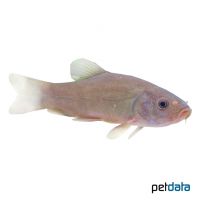Tench (Tinca tinca)
| Tench Tinca tinca | |
|---|---|
| Name | Tench |
| Name Lat. | Tinca tinca |
| Family | Tenches |
| Family lat. | Tincidae |
| Order | Carps |
| Order lat. | Cypriniformes |
| Origin | Europe, Asia |
| Habitat | Ponds, oxbow lakes |
| Diet | Omnivore |
| pH | 6.5-7.5 |
| Behavior | Peaceful |
| Keeping | Group |
| Care Level | Easy |
| Reproduction | Substrate spawner |
| Breeding | Moderately difficult |
| Life Span | 15-20 years |
| Protection | No |
| Metric Units | |
| Size | 30-35 cm |
| Temperature | 4-24 °C |
| Hardness | < 20 °dH |
| Aquarium | Pond |
| US Units | |
| Size | 12"-14" |
| Temperature | 39-75 °F |
| Hardness | < 356 ppm |
| Aquarium | Pond |
Distribution and habitat
The original range of the tench extends from Western Europe to Siberia and they are absent only in Ireland and northern Scandinavia. They live in groups mostly in stagnant waters, such as lakes, ponds and in shallow oxbows of rivers with muddy-sandy bottoms and dense underwater vegetation
Maintenance
They require sufficiently large ponds, which should be furnished with pond, floating and oxygenating underwater plants (milfoil, waterweed, hornwort, etc.), large river pebbles and a soft substrate suitable for burrowing, as well as offering slightly shaded light and free swimming space.
No ammonia, ammonium or nitrite should be detectable in the water, and the nitrate value should not exceed 100 mg/l. To ensure the water quality and oxygen content, a filter adapted to the water volume should not be missing.
Diet
They feed on detritus, insect larvae, snails and soft plant parts. The food supply consists of a high quality sinking dry food (granules, pellets) for pond fish. In addition, they need some vegetable food, such as aquatic plants (Rizzia flutians, etc.) or dry food with high vegetable content (spirulina) and live food, such as daphnia, tubifex or mosquito larvae, which is easily accepted even in frozen form
Regular and varied feeding promotes health and increases resistance.
Behaviour and compatibility
They are calm, peaceful and sociable fish that do not show any aggressive or incompatible behavior. At least 5, but preferably more tench should be kept together. They can be well socialized with other peaceful fish, such as orfe, rudd or gobies
Basically, only compatible fish species with similar demands on water condition and water temperature should be socialized.
Reproduction and breeding
The sexes are difficult to distinguish. Males have slightly larger fins than females and the 2nd pectoral fin ray is thickened.
The females spawn in shoals between May and September, at a water temperature of 19-20 °C, in shallow, densely vegetated shore areas. Over the period of about 2 months, sticky green eggs are spawned over aquatic plants every 1-5 days. After about 3-5 days, the larvae hatch and attach themselves to aquatic plants until their yolk sac is exhausted. The fry grow very slowly and become sexually mature after 3-4 years. Life expectancy can be up to 20 years.
Important
Tench are mainly crepuscular and nocturnal, burrowing in the soft bottom in search of food. During the day they usually keep hidden among the water plants and are rarely seen in the pond.
If they are overwintered in the pond, sufficient depth and oxygen supply (filter, oxygen dispenser, ice free holder) must be ensured
At temperatures below 8-10 °C the metabolism of the fish slows down and food is no longer accepted, feeding must be stopped accordingly. If the temperature drops further, they will hibernate buried in the mud. In spring, with rising temperatures, feeding can slowly be resumed. Feeding may also be necessary during prolonged warm periods in winter.
The well-being of the fish should be monitored regularly. A regular partial water change, according to the pond size is recommended, even if the pollutant load has not yet reached the upper limit. Sudden changes in water quality should be avoided. Newly introduced fish must be accustomed slowly to the water in the pond
Further literature can be found in your pet store.
References
Text: Werner Winter; Image: petdata
Source: BMELV (1998): Tierschutzgutachten - Haltung von Zierfischen (Süßwasser); BAENSCH & RIEHL (2006): Aquarien Atlas Bd. 5, Mergus Verlag; ENGELMANN (2005): Zootierhaltung - Tiere in menschlicher Obhut: Fische; Harri Deutsch Verlag
- Gemäß § 21 Abs. 5 Tierschutzgesetz idgF
